Improved Resolution of Drought Monitoring in the Yellow River Basin Based on a Daily Drought Index Using GRACE Data
Abstract
1. Introduction
2. Study Area and Datasets
2.1. Study Area
2.2. Data
2.2.1. TWSA Products
2.2.2. Temperature and Precipitation Data
2.2.3. GNSS Data
2.2.4. Drought Index
2.2.5. Auxiliary Datasets
3. Method
3.1. Daily TWSA Reconstruction Method
3.2. Time Series Decomposition Method
3.3. GNSS Inversion
3.4. Daily Drought Severity Index
3.5. Reconstruction of Climate-Driven Water Storage Anomalies
4. Result
4.1. Temporal and Spatial Variations in TWSA in the YRB
4.2. Comparison of Daily TWSA
4.2.1. Evaluation of Daily TWSA for GRCAE Reconstruction
4.2.2. Evaluation of Daily TWSA for GNSS Inversion
4.3. Evaluation of DDSI in the YRB
4.3.1. Temporal Variation of Drought in the YRB
4.3.2. Spatial Distribution of Peak Drought Events
5. Discussion
5.1. Spatial Distribution of the Extreme Drought in the YRB During 2010–2011
5.2. Impact of Climate and Human Factors for Drought
6. Conclusions
Author Contributions
Funding
Data Availability Statement
Acknowledgments
Conflicts of Interest
References
- Tran, T.-N.-D.; Lakshmi, V. Enhancing Human Resilience against Climate Change: Assessment of Hydroclimatic Extremes and Sea Level Rise Impacts on the Eastern Shore of Virginia, United States. Sci. Total Environ. 2024, 947, 174289. [Google Scholar] [CrossRef] [PubMed]
- Kafi, K.M.; Ponrahono, Z. Advances in Weather and Climate Extreme Studies: A Systematic Comparative Review. Discov. Geosci. 2024, 2, 66. [Google Scholar] [CrossRef]
- Hermans, K.; McLeman, R. Climate Change, Drought, Land Degradation and Migration: Exploring the Linkages. Curr. Opin. Environ. Sustain. 2021, 50, 236–244. [Google Scholar] [CrossRef]
- Nandgude, N.; Singh, T.P.; Nandgude, S.; Tiwari, M. Drought Prediction: A Comprehensive Review of Different Drought Prediction Models and Adopted Technologies. Sustainability 2023, 15, 11684. [Google Scholar] [CrossRef]
- Tapley, B.D.; Bettadpur, S.; Ries, J.C.; Thompson, P.F.; Watkins, M.M. GRACE Measurements of Mass Variability in the Earth System. Science 2004, 305, 503–505. [Google Scholar] [CrossRef]
- Elhaddad, H.; Sultan, M.; Yan, E.; Abdelmohsen, K.; Mohammad, A.T.; Badawy, A.; Karimi, H.; Saleh, H.; Emil, M.K. Optimization of Floodwater Redistribution from Lake Nasser Could Recharge Egypt’s Aquifers and Mitigate Its Excessive Floods. Commun. Earth Environ. 2024, 5, 385. [Google Scholar] [CrossRef]
- Luo, Z.; Yao, C.; Li, Q.; Huang, Z. Terrestrial Water Storage Changes over the Pearl River Basin from GRACE and Connections with Pacific Climate Variability. Geod. Geodyn. 2016, 7, 171–179. [Google Scholar] [CrossRef]
- Yao, C.; Luo, Z.; Wang, H.; Li, Q.; Zhou, H. GRACE-Derived Terrestrial Water Storage Changes in the Inter-Basin Region and Its Possible Influencing Factors: A Case Study of the Sichuan Basin, China. Remote Sens. 2016, 8, 444. [Google Scholar] [CrossRef]
- Meng, F.; Su, F.; Li, Y.; Tong, K. Changes in Terrestrial Water Storage During 2003–2014 and Possible Causes in Tibetan Plateau. J. Geophys. Res. 2019, 124, 2909–2931. [Google Scholar] [CrossRef]
- Xu, G.; Liu, S.; Cheng, S.; Zhang, Y.; Wu, X.; Wu, Y. Quantifying the 2022 Drought and Spatiotemporal Evolution of TWSA in the Dongting Lake Basin over the Past Two Decades. Geod. Geodyn. 2024, 15, 516–527. [Google Scholar] [CrossRef]
- Ramillien, G.; Frappart, F.; Guntner, A.; Ngo-Duc, T.; Cazenave, A.; Laval, K. Time Variations of the Regional Evapotranspiration Rate from Gravity Recovery and Climate Experiment (GRACE) Satellite Gravimetry. Water Resour. Res. 2006, 42, W10403. [Google Scholar] [CrossRef]
- Syed, T.H.; Famiglietti, J.S.; Rodell, M.; Chen, J.; Wilson, C.R. Analysis of Terrestrial Water Storage Changes from GRACE and GLDAS. Water Resour. Res. 2008, 44, W02433. [Google Scholar] [CrossRef]
- Yeh, P.J.-F.; Swenson, S.C.; Famiglietti, J.S.; Rodell, M. Remote Sensing of Groundwater Storage Changes in Illinois Using the Gravity Recovery and Climate Experiment (GRACE). Water Resour. Res. 2006, 42, W12203. [Google Scholar] [CrossRef]
- Scanlon, B.R.; Longuevergne, L.; Long, D. Ground Referencing GRACE Satellite Estimates of Groundwater Storage Changes in the California Central Valley, USA. Water Resour. Res. 2012, 48, W04520. [Google Scholar] [CrossRef]
- Zhang, G.; Zheng, W.; Yin, W.; Lei, W. Improving the Resolution and Accuracy of Groundwater Level Anomalies Using the Machine Learning-Based Fusion Model in the North China Plain. Sensors 2020, 21, 46. [Google Scholar] [CrossRef]
- Wang, X.; Zheng, W.; Yin, W.; Xu, K.; Zhang, H.; Lei, W. Enhancing Spatial Resolution of Drought Monitoring through a Novel Random Forest-Based GRACE Drought Index: A Case Study in Central Yunnan. Geocarto Int. 2024, 39, 2387784. [Google Scholar] [CrossRef]
- Yin, W.; Hu, L.; Zhang, M.; Wang, J.; Han, S. Statistical Downscaling of GRACE-Derived Groundwater Storage Using ET Data in the North China Plain. J. Geophys. Res. Atmos. 2018, 123, 5973–5987. [Google Scholar] [CrossRef]
- Chen, Z.; Zheng, W.; Yin, W.; Li, X.; Zhang, G.; Zhang, J. Improving the Spatial Resolution of GRACE-Derived Terrestrial Water Storage Changes in Small Areas Using the Machine Learning Spatial Downscaling Method. Remote Sens. 2021, 13, 4760. [Google Scholar] [CrossRef]
- Chu, J.; Su, X.; Zhang, T.; Lei, Y.; Jiang, T.; Wu, H.; Wang, Q. Comparison of Three Spatial Downscaling Concepts of GRACE Data Using Random Forest Model. J. Lake Sci. 2024, 36, 951–962. [Google Scholar] [CrossRef]
- Gouweleeuw, B.T.; Kvas, A.; Gruber, C.; Gain, A.K.; Mayer-Gürr, T.; Flechtner, F.; Güntner, A. Daily GRACE Gravity Field Solutions Track Major Flood Events in the Ganges–Brahmaputra Delta. Hydrol. Earth Syst. Sci. 2018, 22, 2867–2880. [Google Scholar] [CrossRef]
- Kvas, A.; Behzadpour, S.; Ellmer, M.; Klinger, B.; Strasser, S.; Zehentner, N.; Mayer-Gürr, T. ITSG-Grace2018: Overview and Evaluation of a New GRACE-Only Gravity Field Time Series. J. Geophys. Res. Solid Earth 2019, 124, 9332–9344. [Google Scholar] [CrossRef]
- Humphrey, V.; Gudmundsson, L. GRACE-REC: A Reconstruction of Climate-Driven Water Storage Changes over the Last Century. Earth Syst. Sci. Data 2019, 11, 1153–1170. [Google Scholar] [CrossRef]
- Xiao, C.; Zhong, Y.; Feng, W.; Gao, W.; Wang, Z.; Zhong, M.; Ji, B. Monitoring the Catastrophic Flood with GRACE-FO and Near-Real-Time Precipitation Data in Northern Henan Province of China in July 2021. IEEE J. Sel. Top. Appl. Earth Obs. Remote Sens. 2023, 16, 89–101. [Google Scholar] [CrossRef]
- Wang, L.; Zhang, M.; Yin, W.; Li, Y.; Hu, L.; Fan, L. Improved Drought Characteristics in the Pearl River Basin Based on Reconstructed GRACE Solution with Enhanced Temporal Resolution. Remote Sens. 2023, 15, 4849. [Google Scholar] [CrossRef]
- Van Dam, T.M.; Wahr, J. Modeling Environment Loading Effects: A Review. Phys. Chem. Earth 1998, 23, 1077–1087. [Google Scholar] [CrossRef]
- Wang, L.; Chen, C.; Zou, R.; Du, J.; Chen, X. Using GPS and GRACE to Detect Seasonal Horizontal Deformation Caused by Loading of Terrestrial water: A Case Study in the Himalayas. Chin. J. Geophys. 2014, 57, 1792–1804. [Google Scholar] [CrossRef]
- Ding, Y.; Huang, D.; Shi, Y.; Jiang, Z.; Chen, T. Determination of Vertical Surface Displacements in Sichuan Using GPS and GRACE Measurements. Chin. J. Geophys. 2018, 61, 4777–4788. [Google Scholar] [CrossRef]
- Knappe, E.; Bendick, R.; Martens, H.R.; Argus, D.F.; Gardner, W.P. Downscaling Vertical GPS Observations to Derive Watershed-Scale Hydrologic Loading in the Northern Rockies. Water Resour. Res. 2019, 55, 391–401. [Google Scholar] [CrossRef]
- Han, S.; Razeghi, S.M. GPS Recovery of Daily Hydrologic and Atmospheric Mass Variation: A Methodology and Results from the Australian Continent. J. Geophys. Res. Solid Earth 2017, 122, 9328–9343. [Google Scholar] [CrossRef]
- Jiang, Z.; Hsu, Y.-J.; Yuan, L.; Cheng, S.; Li, Q.; Li, M. Estimation of Daily Hydrological Mass Changes Using Continuous GNSS Measurements in Mainland China. J. Hydrol. 2021, 598, 126349. [Google Scholar] [CrossRef]
- Peng, Y.; Chen, G.; Chao, N.; Wang, Z.; Wu, T.; Luo, X. Detection of Extreme Hydrological Droughts in the Poyang Lake Basin during 2021–2022 Using GNSS-Derived Daily Terrestrial Water Storage Anomalies. Sci. Total Environ. 2024, 919, 170875. [Google Scholar] [CrossRef] [PubMed]
- She, D.; Xia, J.; Du, H.; Wan, L. Spatio-temporal Analysis and Multi-variable Statistical Models of Extreme Drought Events in Yellow River Basin, China. J. Basic Sci. Eng. 2012, 20, 15–29. Available online: https://kns.cnki.net/KCMS/detail/detail.aspx?dbcode=CJFQ&dbname=CJFD2012&filename=YJGX2012S1001 (accessed on 2 September 2024).
- Cao, C.; Ren, L.; Liu, Y.; Jiang, S.; Zhang, L.; Zhang, L. Spatial-Temporal Characteristics of Drought of the Yellow River Basin Based on Joint Drought Index. Yellow River 2019, 41, 51–56. [Google Scholar] [CrossRef]
- Qu, W.; Jin, Z.; Zhang, Q.; Gao, Y.; Zhang, P. Drought characteristics of the Yellow River basin from 2002 to 2020 revealed by GRACE and GRACE Follow-On data. Acta Geod. Cartogr. Sinica 2023, 52, 714–724. [Google Scholar] [CrossRef]
- Xie, X.; Xing, M.; Wang, L.; Xu, G.; Wen, H. Using GRACE/GRACE-FO Gravity Satellite to Detect the Water Storage Capacity and the Possibility of Extreme Climate in the Yellow River Basin. J. Geod. Geodyn. 2022, 42, 1269–1275. [Google Scholar] [CrossRef]
- Yuan, Z.; Zhang, Z.; Yan, J.; Liu, J.; Hu, Z.; Wang, Y.; Cai, M. Spatiotemporal characteristics of different grades of precipitation in Yellow River Basin from 1960 to 2020. Arid Zone Res. 2024, 41, 1259–1271. [Google Scholar] [CrossRef]
- Ji, X.; Liu, M.; Wu, X.; Ding, Y.; Zhu, Y. Spatiotemporal variation characteristics of rainfall erosivity in the Yellow River Basin from 1961 to 2019. Trans. Chin. Soc. Agric. Eng. 2022, 38, 136–145. [Google Scholar] [CrossRef]
- Li, C.; Yu, W.; Zhang, X. Spatio-Temporal Patterns of High-Quality Urbanization Development under Water Resource Constraints and Their Key Drivers: A Case Study in the Yellow River Basin, China. Ecol. Indic. 2024, 166, 112441. [Google Scholar] [CrossRef]
- Save, H.; Bettadpur, S.; Tapley, B.D. High-resolution CSR GRACE RL05 Mascons. J. Geophys. Res. 2016, 121, 7547–7569. [Google Scholar] [CrossRef]
- Wiese, D.N.; Landerer, F.W.; Watkins, M.M. Quantifying and Reducing Leakage Errors in the JPL RL05M GRACE Mascon Solution. Water Resour. Res. 2016, 52, 7490–7502. [Google Scholar] [CrossRef]
- Li, B.; Rodell, M.; Kumar, S.; Beaudoing, H.K.; Getirana, A.; Zaitchik, B.F.; Goncalves, L.G.; Cossetin, C.; Bhanja, S.; Mukherjee, A.; et al. Global GRACE Data Assimilation for Groundwater and Drought Monitoring: Advances and Challenges. Water Resour. Res. 2019, 55, 7564–7586. [Google Scholar] [CrossRef]
- Li, B.; Beaudoing, H.; Rodell, M. NASA/GSFC/HSL, GLDAS Catchment Land Surface Model L4 Daily 0.25 × 0.25 Degree GRACE-DA1 V2.2, Greenbelt, Maryland, USA, Goddard Earth Sciences Data and Information Services Center (GES DISC). Available online: https://disc.gsfc.nasa.gov/datasets/GLDAS_CLSM025_DA1_D_2.2/summary (accessed on 14 April 2024).
- Mayer-Gürr, T.; Behzadpur, S.; Ellmer, M.; Kvas, A.; Klinger, B.; Strasser, S.; Zehentner, N. ITSG-Grace2018—Monthly, Daily and Static Gravity Field Solutions from GRACE. GFZ Data Serv. Available online: https://www.tugraz.at/institute/ifg/downloads/gravity-field-models/itsg-grace2018 (accessed on 6 June 2024).
- Xu, Y.; Gao, X.; Shen, Y.; Xu, C.; Shi, Y.; Giorgi, F. A Daily Temperature Dataset over China and Its Application in Validating a RCM Simulation. Adv. Atmos. Sci. 2009, 26, 763–772. [Google Scholar] [CrossRef]
- Wu, J.; Gao, X. A Gridded Daily Observation Dataset over China Region and Comparison with the Other Datasets. Chin. J. Geophys. 2013, 56, 1102–1111. [Google Scholar] [CrossRef]
- Wu, J.; Gao, X.; Giorgi, F.; Chen, D. Changes of Effective Temperature and Cold/Hot Days in Late Decades over China Based on a High Resolution Gridded Observation Dataset. Int. J. Climatol. 2017, 37, 788–800. [Google Scholar] [CrossRef]
- Nie, S.; Zheng, W.; Yin, W.; Zhong, Y.; Shen, Y.; Li, K. Improved the Characterization of Flood Monitoring Based on Reconstructed Daily GRACE Solutions over the Haihe River Basin. Remote Sens. 2023, 15, 1564. [Google Scholar] [CrossRef]
- Muñoz Sabater, J. ERA5-Land Monthly Averaged Data from 1950 to Present. Copernicus Climate Change Service (C3S) Climate Data Store (CDS). Available online: https://cds.climate.copernicus.eu/cdsapp#!/dataset/reanalysis-era5-land-monthly-means?tab=form (accessed on 2 May 2024).
- Jiao, D.; Xu, N.; Yang, F.; Xu, K. Evaluation of Spatial-Temporal Variation Performance of ERA5 Precipitation Data in China. Sci. Rep. 2021, 11, 17956. [Google Scholar] [CrossRef]
- Zhao, P.; He, Z. A First Evaluation of ERA5-Land Reanalysis Temperature Product over the Chinese Qilian Mountains. Front. Earth Sci. 2022, 10, 907730. [Google Scholar] [CrossRef]
- Wells, N.; Goddard, S.; Hayes, M.J. A Self-Calibrating Palmer Drought Severity Index. J. Clim. 2004, 17, 2335–2351. [Google Scholar] [CrossRef]
- Van Der Schrier, G.; Barichivich, J.; Briffa, K.R.; Jones, P.D. A scPDSI-based Global Data Set of Dry and Wet Spells for 1901–2009. J. Geophys. Res. Atmos. 2013, 118, 4025–4048. [Google Scholar] [CrossRef]
- Yang, Q.; Li, M.; Zheng, Z.; Ma, Z. Regional applicability of seven meteorological drought indices in China. Sci. China Earth Sci. 2017, 47, 337–353. [Google Scholar] [CrossRef]
- Wang, Q.; Zeng, J.; Qi, J.; Zhang, X.; Zeng, Y.; Shui, W.; Xu, Z.; Zhang, R.; Wu, X.; Cong, J. A Multi-Scale Daily SPEI Dataset for Drought Characterization at Observation Stations over Mainland China from 1961 to 2018. Earth Syst. Sci. Data 2021, 13, 331–341. [Google Scholar] [CrossRef]
- Wang, Q.; Zhang, R.; Qi, J.; Zeng, J.; Wu, J.; Shui, W.; Wu, X.; Li, J. An Improved Daily Standardized Precipitation Index Dataset for Mainland China from 1961 to 2018. Sci. Data 2022, 9, 124. [Google Scholar] [CrossRef] [PubMed]
- Liu, X.; Yu, S.; Yang, Z.; Dong, J.; Peng, J. The First Global Multi-Timescale Daily SPEI Dataset from 1982 to 2021. Sci. Data 2024, 11, 223. [Google Scholar] [CrossRef]
- Beaudoing, H.; Rodell, M. GLDAS Noah Land Surface Model L4 Monthly 0.25 × 0.25 Degree V2.1, Greenbelt, Maryland, USA, Goddard Earth Sciences Data and Information Services Center (GES DISC). Available online: https://disc.gsfc.nasa.gov/datasets/GLDAS_NOAH025_M_2.1/summary (accessed on 5 August 2024).
- Rodell, M.; Houser, P.R.; Jambor, U.; Gottschalck, J.; Mitchell, K.; Meng, C.-J.; Arsenault, K.; Cosgrove, B.; Radakovich, J.; Bosilovich, M.; et al. The Global Land Data Assimilation System. Bull. Amer. Meteor. Soc. 2004, 85, 381–394. [Google Scholar] [CrossRef]
- Hosseini-Moghari, S.-M.; Araghinejad, S.; Ebrahimi, K.; Tang, Q.; AghaKouchak, A. Using GRACE Satellite Observations for Separating Meteorological Variability from Anthropogenic Impacts on Water Availability. Sci. Rep. 2020, 10, 15098. [Google Scholar] [CrossRef]
- Kraner, M.L.; Holt, W.E.; Borsa, A.A. Seasonal Nontectonic Loading Inferred from cGPS as a Potential Trigger for the M6.0 South Napa Earthquake. J. Geophys. Res. Solid Earth 2018, 123, 5300–5322. [Google Scholar] [CrossRef]
- Chanard, K.; Fleitout, L.; Calais, E.; Rebischung, P.; Avouac, J. Toward a Global Horizontal and Vertical Elastic Load Deformation Model Derived from GRACE and GNSS Station Position Time Series. J. Geophys. Res. Solid Earth 2018, 123, 3225–3237. [Google Scholar] [CrossRef]
- Jiang, Z.; Hsu, Y.-J.; Yuan, L.; Feng, W.; Yang, X.; Tang, M. GNSS2TWS: An Open-Source MATLAB-Based Tool for Inferring Daily Terrestrial Water Storage Changes Using GNSS Vertical Data. GPS Solut. 2022, 26, 114. [Google Scholar] [CrossRef]
- Jiang, Z.; Hsu, Y.-J.; Yuan, L.; Huang, D. Monitoring Time-Varying Terrestrial Water Storage Changes Using Daily GNSS Measurements in Yunnan, Southwest China. Remote Sens. Environ. 2021, 254, 112249. [Google Scholar] [CrossRef]
- Dziewonski, A.M.; Anderson, D.L. Preliminary Reference Earth Model. Phys. Earth Planet. Inter. 1981, 25, 297–356. [Google Scholar] [CrossRef]
- Fu, Y.; Argus, D.F.; Landerer, F.W. GPS as an Independent Measurement to Estimate Terrestrial Water Storage Variations in Washington and Oregon. J. Geophys. Res. Solid Earth 2015, 120, 552–566. [Google Scholar] [CrossRef]
- Hsu, Y.-J.; Fu, Y.; Bürgmann, R.; Hsu, S.-Y.; Lin, C.-C.; Tang, C.-H.; Wu, Y.-M. Assessing Seasonal and Interannual Water Storage Variations in Taiwan Using Geodetic and Hydrological Data. Earth Planet. Sci. Lett. 2020, 550, 116532. [Google Scholar] [CrossRef]
- Liu, X.; Feng, X.; Ciais, P.; Fu, B.; Hu, B.; Sun, Z. GRACE Satellite-Based Drought Index Indicating Increased Impact of Drought over Major Basins in China during 2002–2017. Agric. For. Meteorol. 2020, 291, 108057. [Google Scholar] [CrossRef]
- Cui, A.; Li, J.; Zhou, Q.; Zhu, R.; Liu, H.; Wu, G.; Li, Q. Use of a Multiscalar GRACE-Based Standardized Terrestrial Water Storage Index for Assessing Global Hydrological Droughts. J. Hydrol. 2021, 603, 126871. [Google Scholar] [CrossRef]
- Zhao, M.; Geruo, A.; Velicogna, I.; Kimball, J.S. Satellite Observations of Regional Drought Severity in the Continental United States Using GRACE-Based Terrestrial Water Storage Changes. J. Clim. 2017, 30, 6297–6308. [Google Scholar] [CrossRef]
- Deng, Z.; Wu, X.; Wang, Z.; Li, J.; Chen, X. Drought monitoring based on GRACE data in the Pearl River Basin, China. Trans. Chin. Soc. Agric. Eng. 2020, 36, 179–187. [Google Scholar] [CrossRef]
- Liu, B.; Zou, X.; Yi, S.; Sneeuw, N.; Cai, J.; Li, J. Identifying and Separating Climate- and Human-Driven Water Storage Anomalies Using GRACE Satellite Data. Remote Sens. Environ. 2021, 263, 112559. [Google Scholar] [CrossRef]
- Zhang, G.; Xu, T.; Yin, W.; Bateni, S.M.; Jun, C.; Kim, D.; Liu, S.; Xu, Z.; Ming, W.; Wang, J. A Machine Learning Downscaling Framework Based on a Physically Constrained Sliding Window Technique for Improving Resolution of Global Water Storage Anomaly. Remote Sens. Environ. 2024, 313, 114359. [Google Scholar] [CrossRef]
- The Ministry of Water Resources of the People’s Republic of China. 2013 Bulletin of Flood and Drought Disasters in China. p. 11. Available online: http://www.mwr.gov.cn/sj/tjgb/zgshzhgb/201612/t20161222_776091.html (accessed on 2 September 2024).
- The Ministry of Water Resources of the People’s Republic of China. 2016 Bulletin of Flood and Drought Disasters in China. p. 38. Available online: http://www.mwr.gov.cn/sj/tjgb/zgshzhgb/201707/t20170720_966705.html (accessed on 2 September 2024).
- The Ministry of Water Resources of the People’s Republic of China. 2011 Bulletin of Flood and Drought Disasters in China. p. 24. Available online: http://www.mwr.gov.cn/sj/tjgb/zgshzhgb/201612/t20161222_776089.html (accessed on 2 September 2024).
- Zhong, Y.; Feng, W.; Humphrey, V.; Zhong, M. Human-Induced and Climate-Driven Contributions to Water Storage Variations in the Haihe River Basin, China. Remote Sens. 2019, 11, 3050. [Google Scholar] [CrossRef]

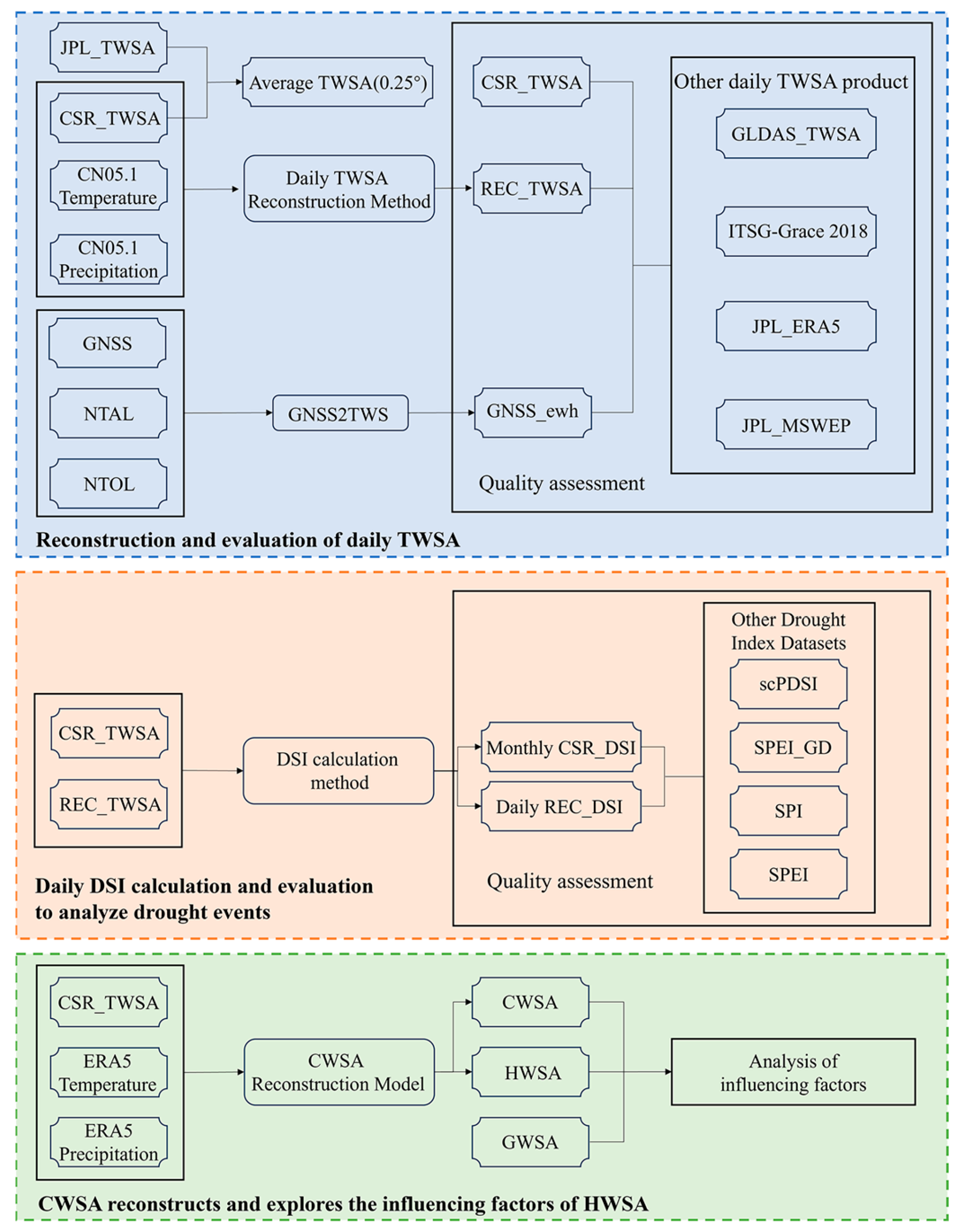
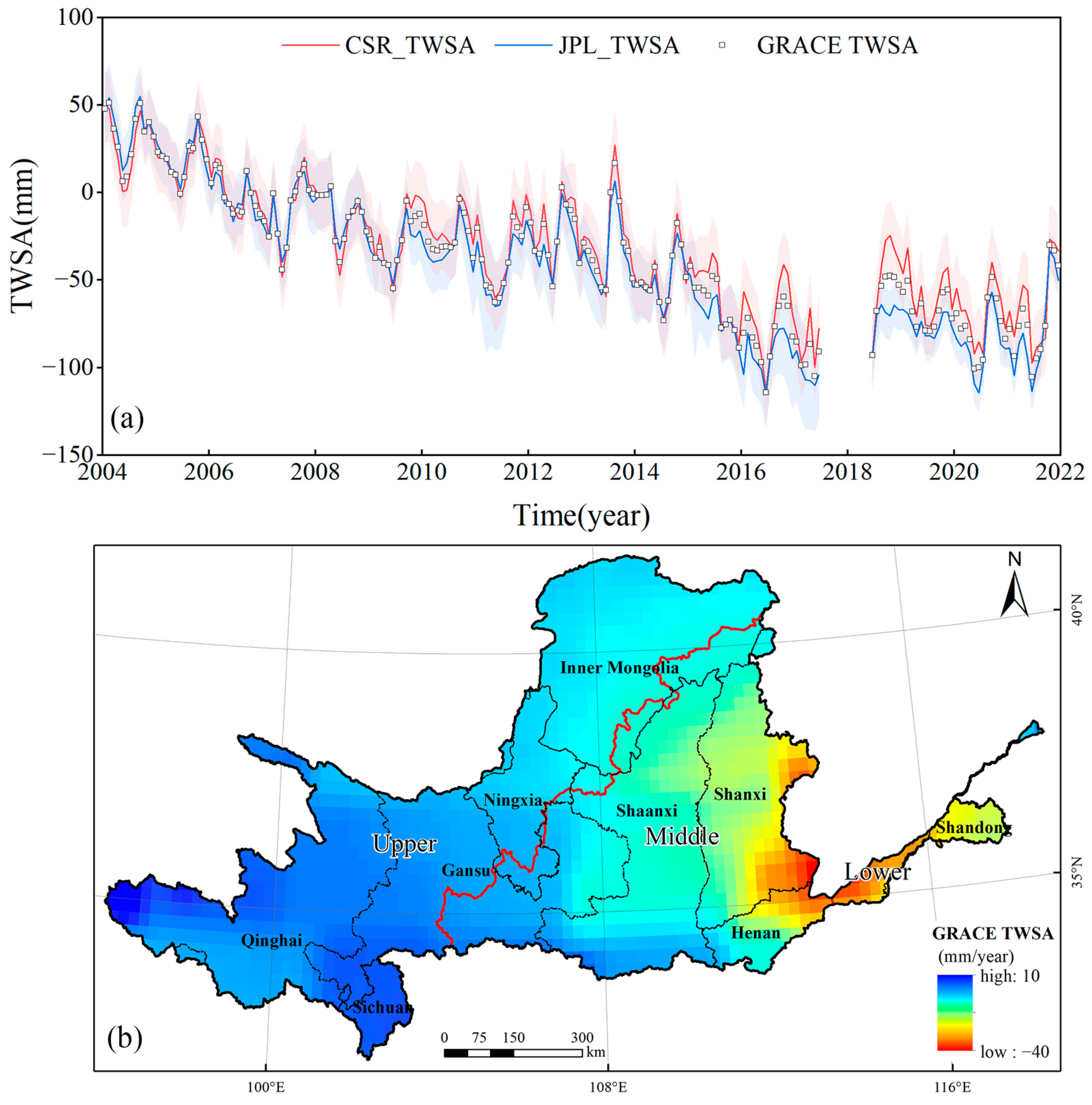

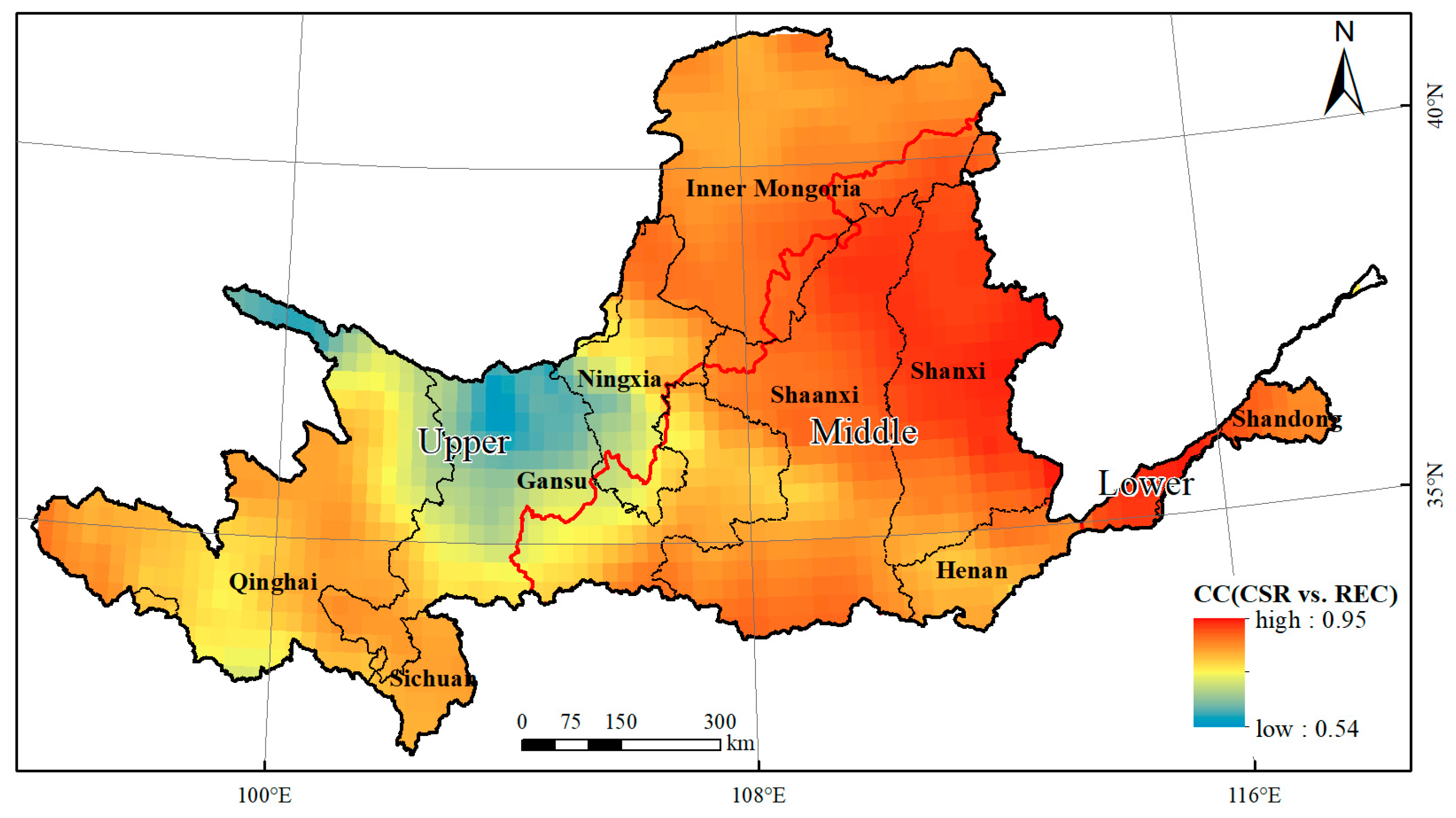
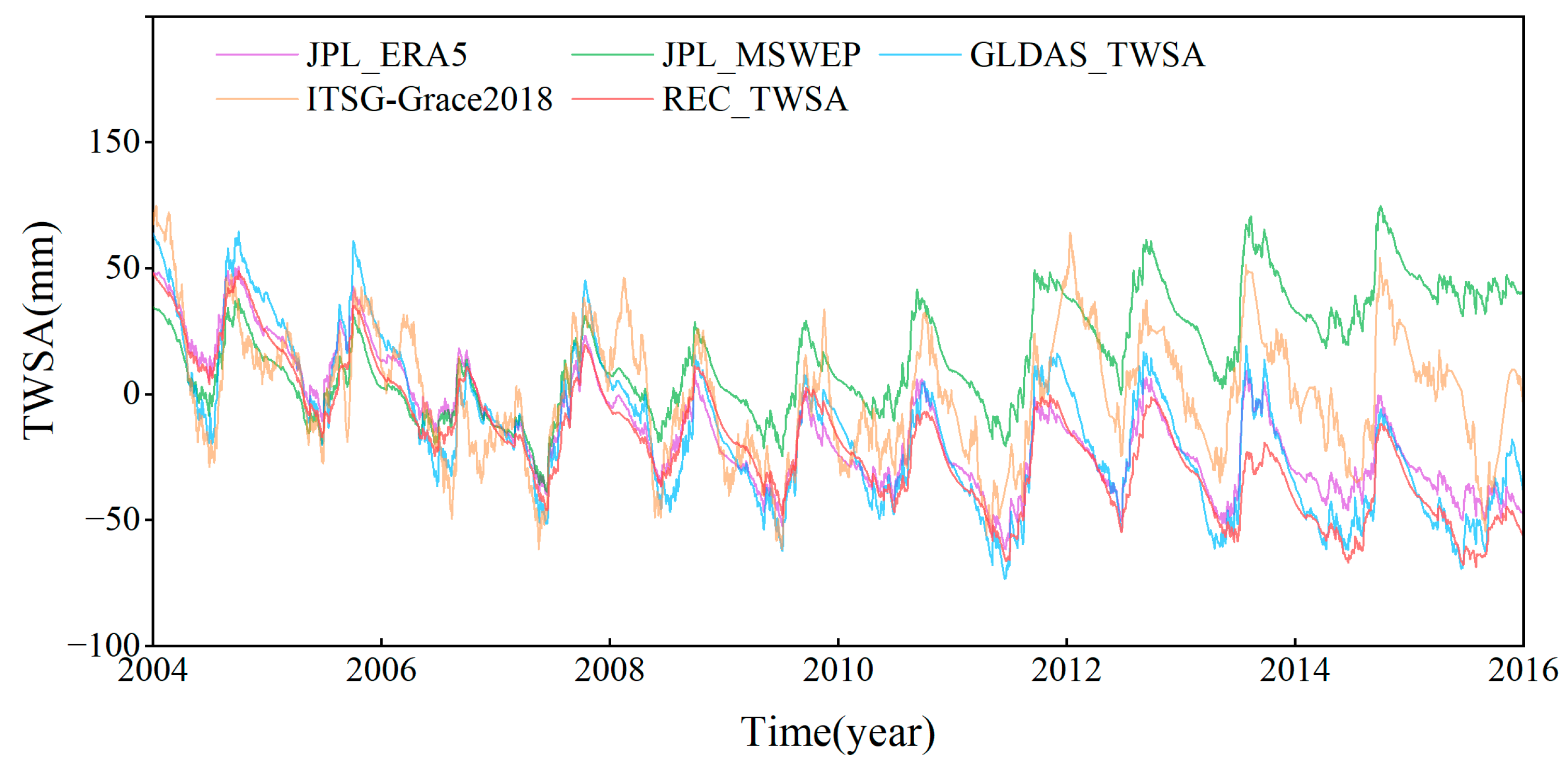
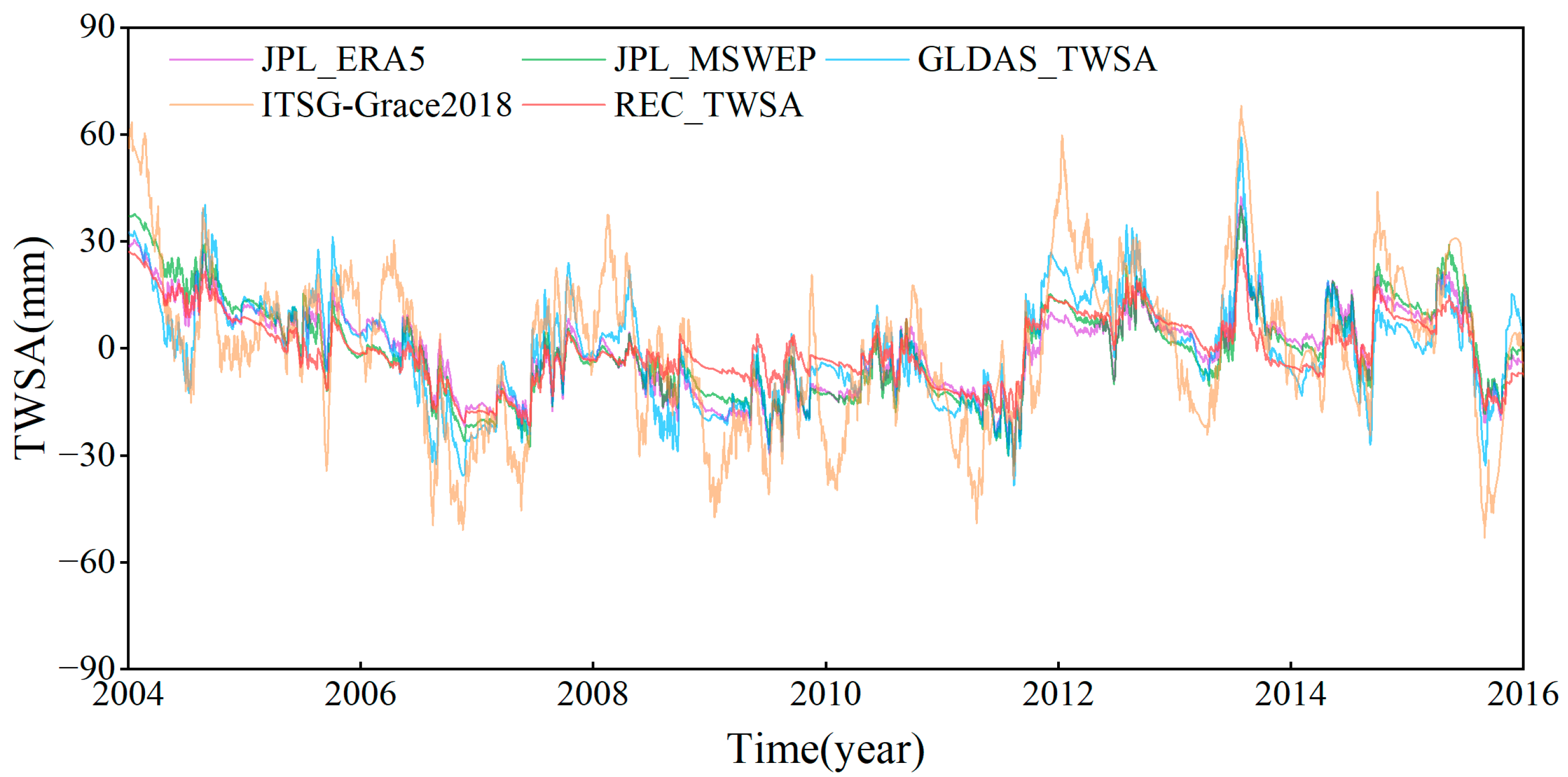

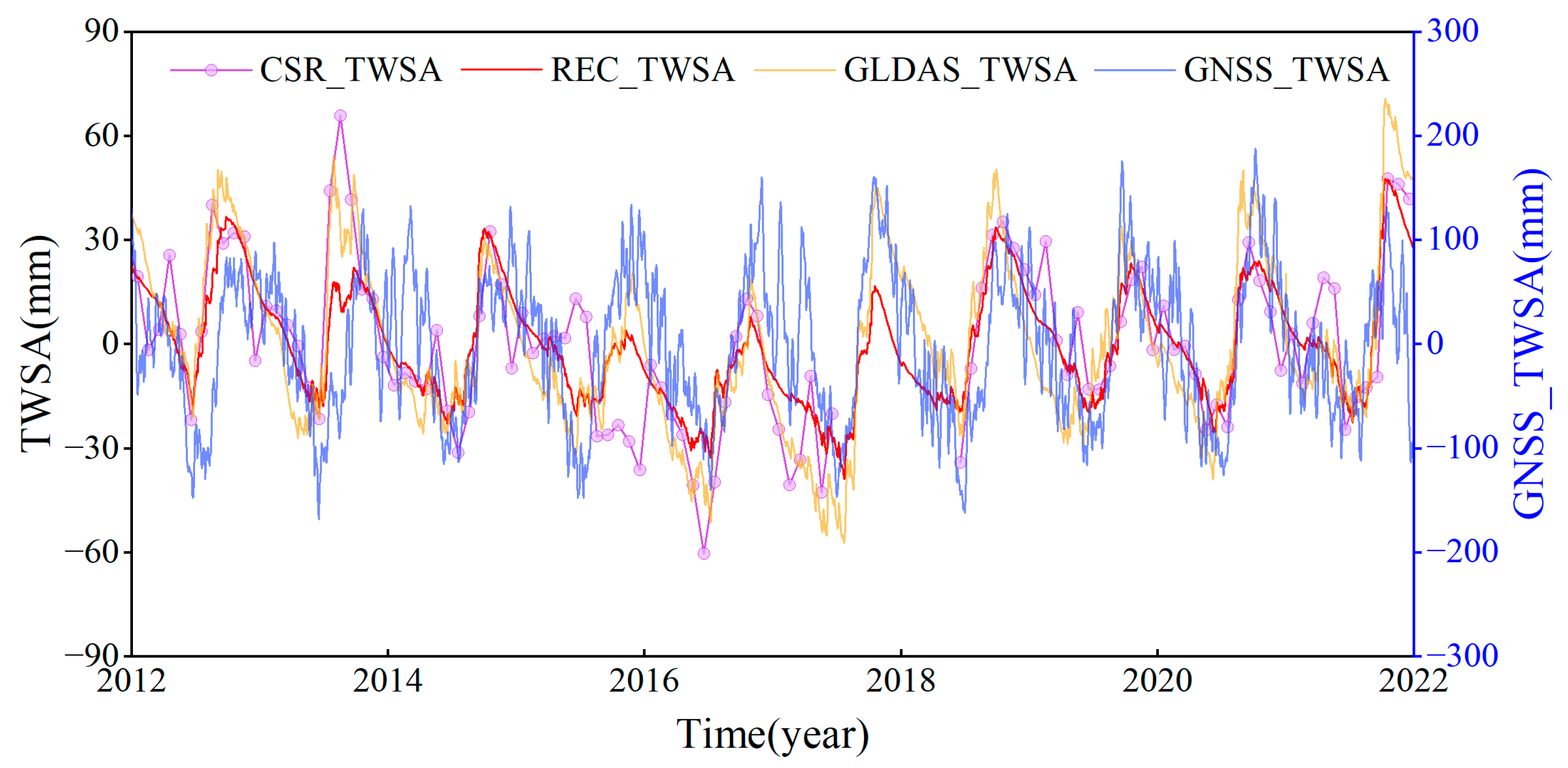
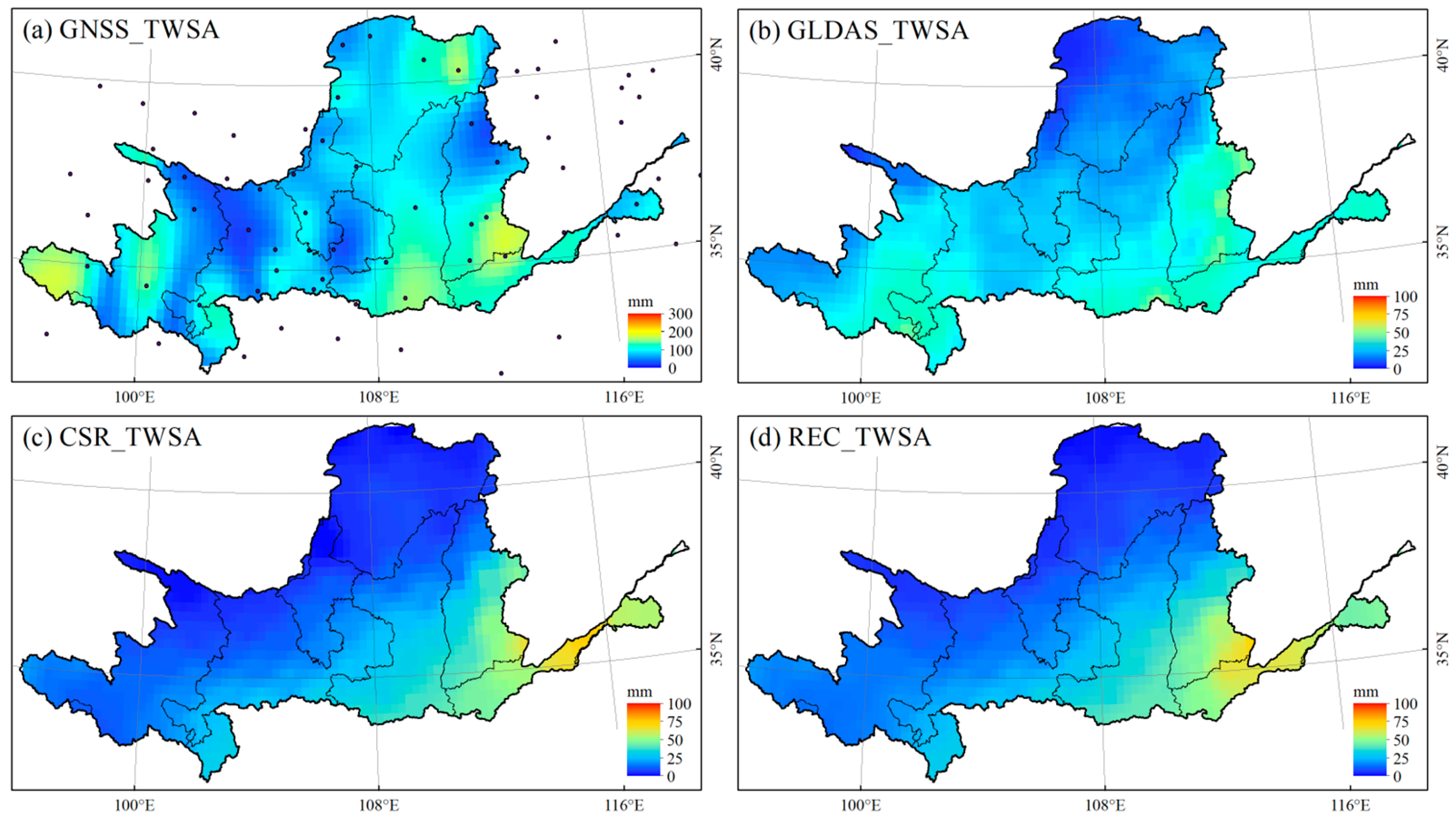
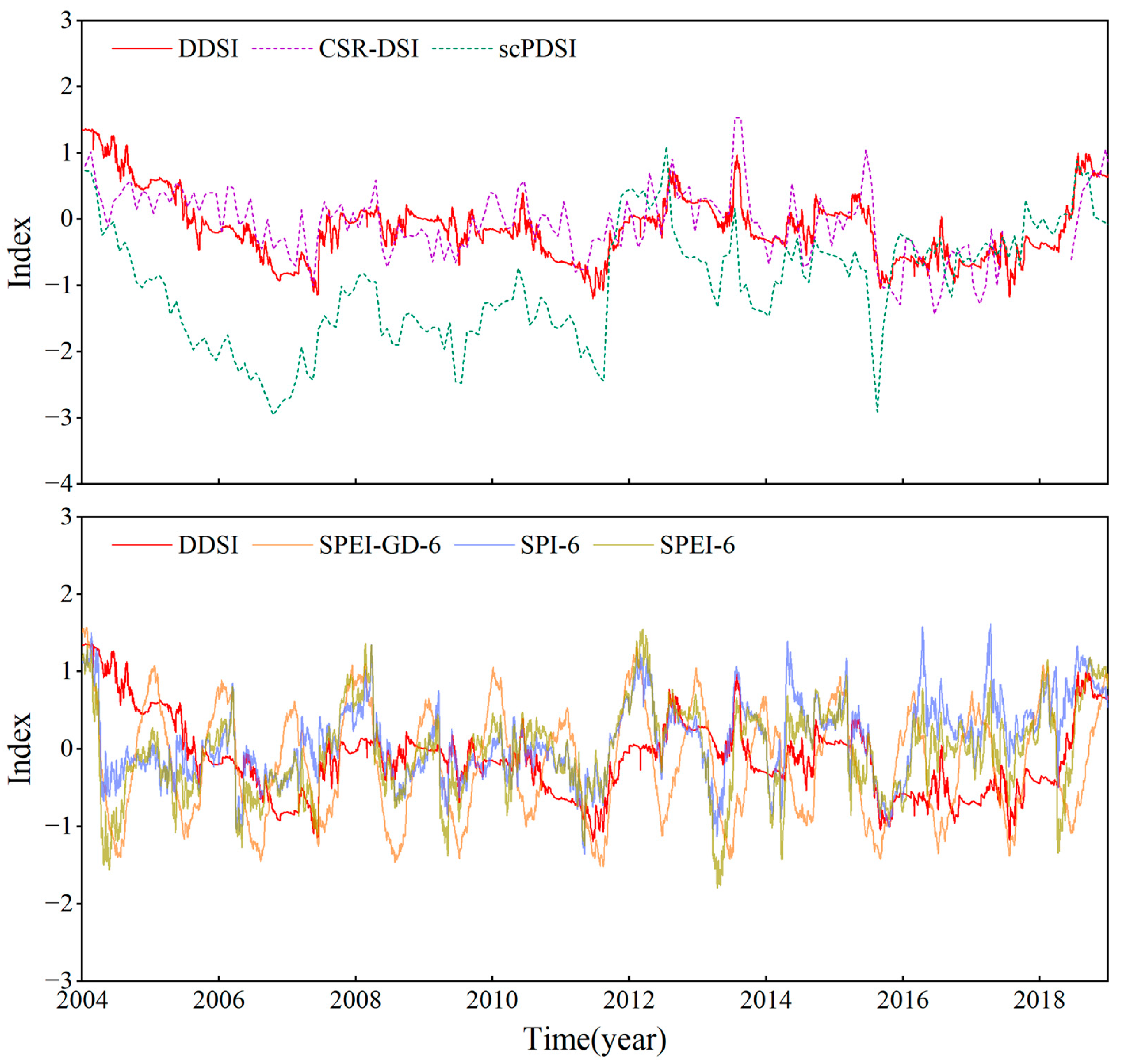


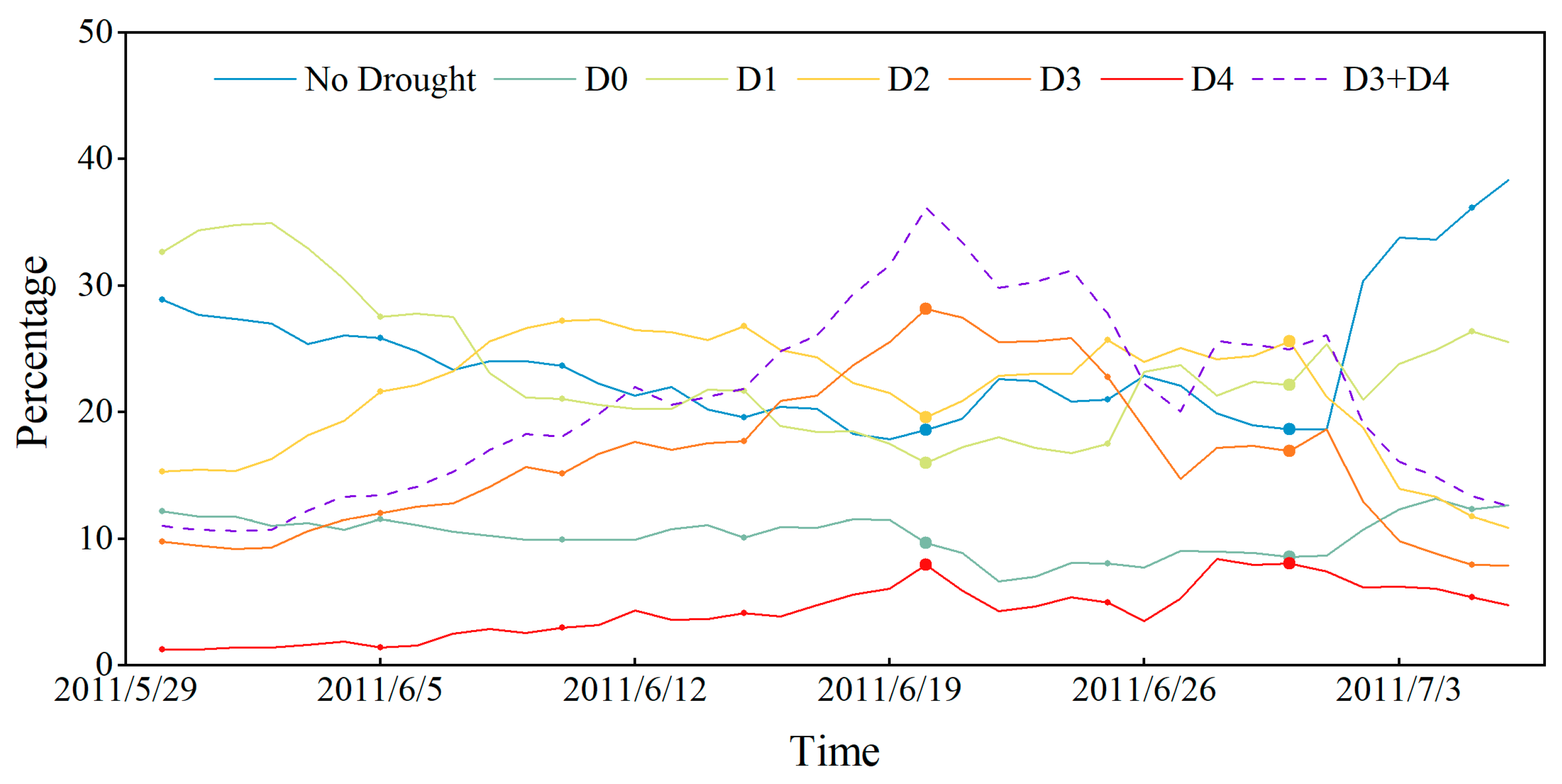

| Category | Description | DDSI | scPDSI | SPI | SPEI | SPEI-GD |
|---|---|---|---|---|---|---|
| D0 | Mild drought | −0.50 to −0.79 | ||||
| D1 | Moderate drought | −0.80 to −1.29 | −1 to −1.99 | −0.5 to −0.99 | −0.5 to −0.99 | −0.5 to −0.99 |
| D2 | Severe drought | −1.30 to −1.59 | −2 to −2.99 | −1 to −1.49 | −1 to −1.49 | −1 to −1.49 |
| D3 | Extreme drought | −1.60 to −1.99 | −3 to −3.99 | −1.5 to −1.99 | −1.5 to −1.99 | −1.5 to −1.99 |
| D4 | Exceptional drought | −2.0 or less | −4 or less | −2 or less | −2 or less | −2 or less |
| ID | Period | Period (Days) | Total Severity | Minimum DDSI | Minimum DDSI Date |
|---|---|---|---|---|---|
| 1 | 2006/9/14 to 2007/3/16 | 184 | −144.55 | −0.93 | 2006/11/18 |
| 2 | 2007/3/19 to 2007/6/17 | 91 | −73.94 | −1.14 | 2007/6/10 |
| 3 | 2010/10/30 to 2011/9/10 | 316 | −238.31 | −1.2 | 2011/6/20 |
| 4 | 2015/8/12 to 2016/6/1 | 295 | −206.73 | −1.04 | 2015/9/2 |
| 5 | 2016/8/29 to 2017/3/22 | 206 | −145.29 | −0.97 | 2016/10/3 |
| TWSA Trend | CWSA Trend | HWSA Trend | GWSA Trend | |
|---|---|---|---|---|
| Yellow River basin | −5.32 ± 0.29 | 0.13 ± 0.18 | −5.45 ± 0.23 | −7.41 ± 0.17 |
| Upper reaches | −1.27 ± 0.26 | 0.11 ± 0.18 | −1.44 ± 0.18 | −4.17 ± 0.14 |
| Middle reaches | −9.12 ± 0.46 | −0.02 ± 0.17 | −9.01 ± 0.44 | −10.52 ± 0.26 |
| Lower reaches | −24.94 ± 1.13 | −0.48 ± 0.44 | −24.39 ± 1.08 | −22.25 ± 0.46 |
Disclaimer/Publisher’s Note: The statements, opinions and data contained in all publications are solely those of the individual author(s) and contributor(s) and not of MDPI and/or the editor(s). MDPI and/or the editor(s) disclaim responsibility for any injury to people or property resulting from any ideas, methods, instructions or products referred to in the content. |
© 2025 by the authors. Licensee MDPI, Basel, Switzerland. This article is an open access article distributed under the terms and conditions of the Creative Commons Attribution (CC BY) license (https://creativecommons.org/licenses/by/4.0/).
Share and Cite
Li, Y.; Zheng, W.; Yin, W.; Nie, S.; Zhang, H.; Lei, W. Improved Resolution of Drought Monitoring in the Yellow River Basin Based on a Daily Drought Index Using GRACE Data. Water 2025, 17, 1245. https://doi.org/10.3390/w17091245
Li Y, Zheng W, Yin W, Nie S, Zhang H, Lei W. Improved Resolution of Drought Monitoring in the Yellow River Basin Based on a Daily Drought Index Using GRACE Data. Water. 2025; 17(9):1245. https://doi.org/10.3390/w17091245
Chicago/Turabian StyleLi, Yingying, Wei Zheng, Wenjie Yin, Shengkun Nie, Hanwei Zhang, and Weiwei Lei. 2025. "Improved Resolution of Drought Monitoring in the Yellow River Basin Based on a Daily Drought Index Using GRACE Data" Water 17, no. 9: 1245. https://doi.org/10.3390/w17091245
APA StyleLi, Y., Zheng, W., Yin, W., Nie, S., Zhang, H., & Lei, W. (2025). Improved Resolution of Drought Monitoring in the Yellow River Basin Based on a Daily Drought Index Using GRACE Data. Water, 17(9), 1245. https://doi.org/10.3390/w17091245






